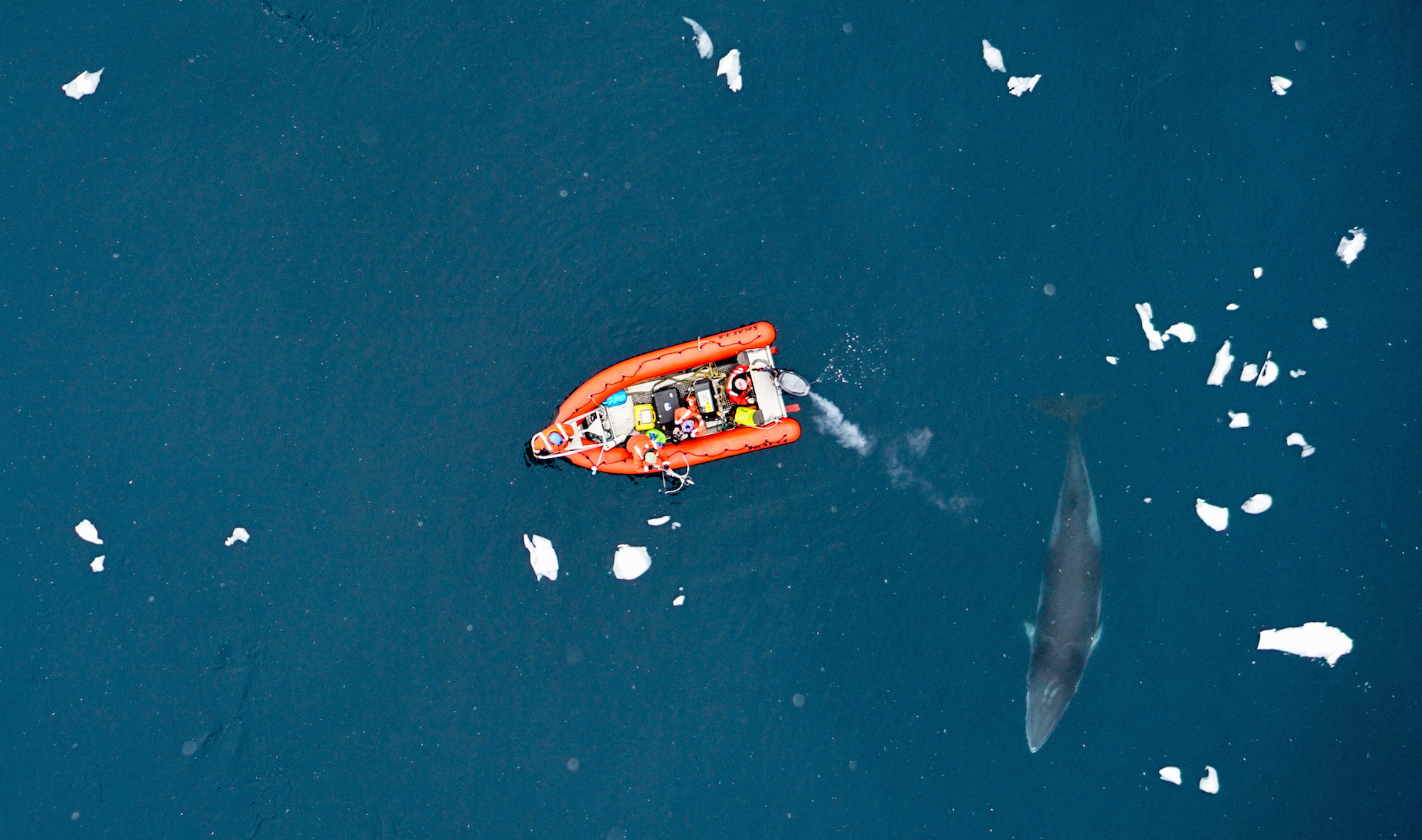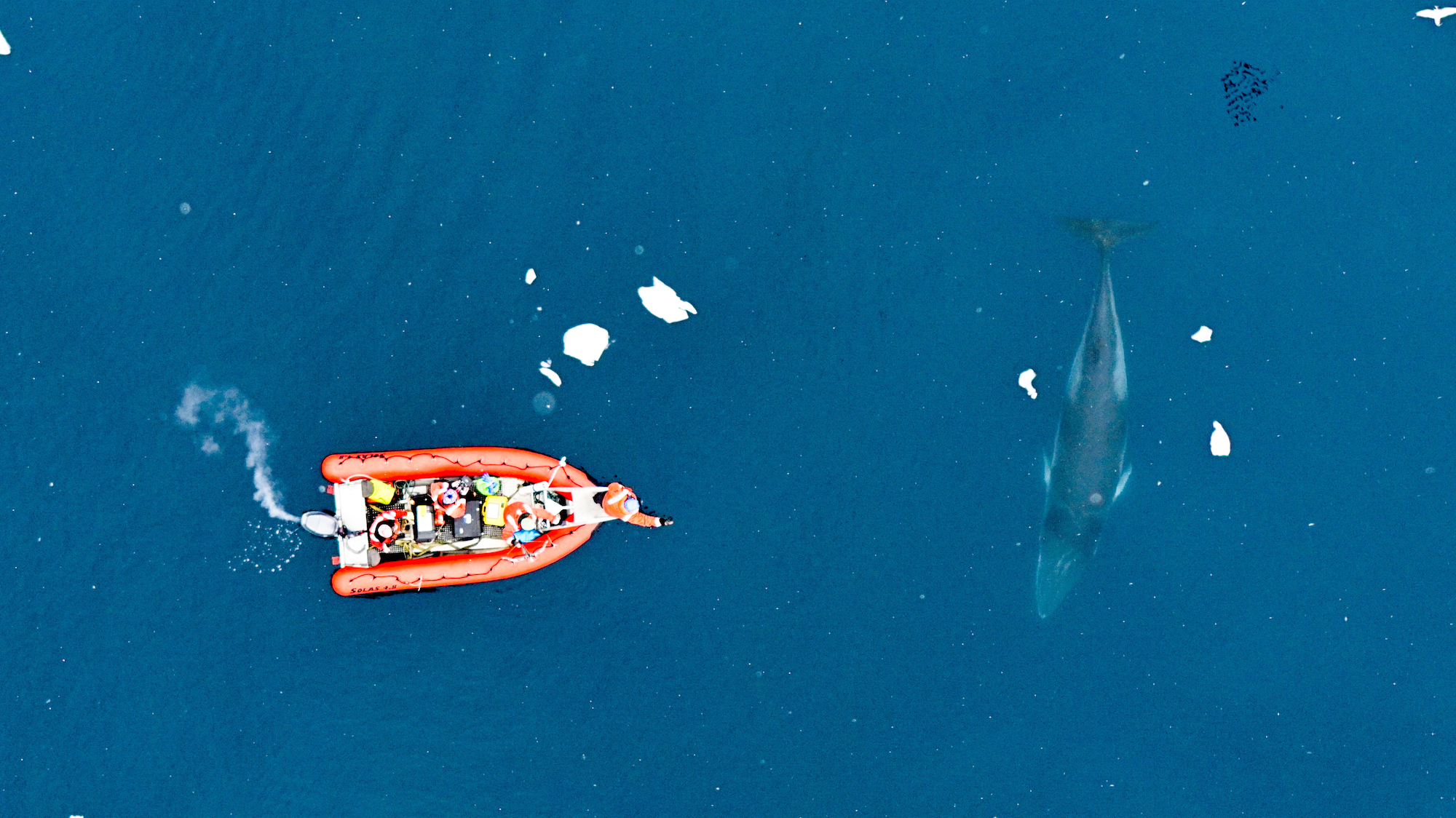A few miles off the coast of the rapidly warming Antarctic Peninsula, scientists are getting their first-ever detailed look at one of the most mysterious mammals on the planet, minke whales.
Smaller cousins of the mammoth blue whale, the elusive minkes have remained mostly out of reach in the deep fjords of the icy Antarctic. It wasn’t until earlier this month that a team of scientists using an array of drones, suction-cap tags, and whale-mounted video cameras uncovered some basic facts about the species, such as their average size and how they moved. They discovered that minkes, long thought to be loners, are outgoing and social. They found out that minkes had spots.
Jeremy Goldbogen, an ecologist from Stanford who helped develop a new type of video tag to study these whales, was surprised to find six minkes feeding together at the same time. “For some reason they’re synchronizing their foraging behavior,” he said. “We don’t know a lot about that.”
There are likely hundreds of thousands of minkes, making them one of the most plentiful whale species. But shrinking Antarctic sea ice is destroying their habitat.
David Johnston, a marine ecologist at Duke University, said the expedition is an “opportunity for science to understand how we’re affecting the planet over the long term.”
The research team shared some of their pictures and video exclusively with Grist. These images from a remote corner of the world offer a window into minkes’ little-known lives, and they also underscore a hidden aspect of human-made climate change: We barely understand what we’re losing.
The Antarctic Peninsula is warming at a rate four times that of the rest of the planet, leading to large losses of sea ice and a catastrophic collapse of huge ice shelves, prime habitat for ice-loving minkes. Last year, a trillion-ton iceberg — one of the largest ever recorded — broke away from the peninsula’s Larsen C ice shelf. In the decades to come, the rate of ice melt will double, and more ice shelves could collapse later this century should the world continue to warm at its current rate.
The slow destruction of the whales’ habitat adds extra urgency to their mission. It’s a true “race against the clock,” said Ari Friedlaender, an ecologist at UC Santa Cruz. I spoke with Friedlaender earlier this month as he and his crew arrived back at Palmer Station — fresh off the icebreaker that served as their base of operations, the R/VLaurence M. Gould. Friedlaender was the first person to tag minke whales a couple of years ago, which helped him gather the support he needed from the National Science Foundation to mount this year’s expedition.
On a trip to Antarctic waters in 2014, Friedlaender’s team learned that minkes rely on intact sea ice for their meals. Using an earlier version of their whale tag, the team found that the whales skim the underside of the ice hunting for krill, the tiny crustaceans that make up the bulk of their diet. No other whale species exhibits this behavior.
“We know the changing ice conditions affect their main food source, krill,” says David Johnston, an ecologist from Duke University on the team and an expert in the use of drones for marine conservation. “And so as the peninsula warms, we’re trying to figure out exactly how the whales are going to respond.”
The research team’s efforts are the latest attempt to crack secrets buried in Earth’s oceans. Just a few years ago, another team of scientists realized that the bristlemouth, a finger-sized fish that occupies the middle-depths of the seas, was the most common vertebrate animal on Earth. Last year, an exploration just a few miles off the California coast discovered an entire ecosystem filled with corals, sponges, and echinoderms — smack in the middle of a zone with minimal oxygen. Meanwhile, there’s new evidence that humanity has has left its fingerprints on every corner of the planet, from putting microplastics in the Arctic to launching new efforts to mine the deep ocean. Entire ecosystems have disappeared before we even knew they existed. (h/t to the many folks in this Twitter thread for these examples)
All of this is a reminder of just how strange our current moment on Earth is. It’s taken a little more than 100 years for people to remake the surface of the planet, and now our atmosphere is changing at a pace beyond that of any point in known planetary history. Yet we’re still learning basic facts about the many creatures we share this world with.

Members of the research team looking for whales to tag. “You have to kind of fake yourself out for a moment and not think about where you are, what those animals are, and you just have this task to do to put a tag on an animal,” Friedlaender says. “Once it’s over you can look at it and think, ‘Oh my God, that’s a minke whale—we just put down three tags in five minutes, that’s unheard of.’” Mary Lide Parker

Friedlaender prepares to tag a minke in Andvord Bay, Antarctica. “We could go for days and not see any minkes and then it could go from bust to boom and we’d be putting the tags on as quickly as possible,” says Jeremy Goldbogen, an ecologist from Stanford on the trip. “In five minutes, we tripled the amount of information in the world on one of the most difficult species to study.” Mary Lide Parker

Two humpback whales swim in Ciera Cove with the team’s base of operations, the ASRV Gould, in the background. “We’re working in the Antarctic Peninsula area in these very long and deep fjords,” Johnston says. “Everywhere you look right now you see penguins and seals and whales. It’s hard not to look out across the water and see something alive and amazing.”
Mary Lide Parker

“They’re often very curious,” Johnston says, “so I suspect they are trying to understand what we are. We’re often riding around in zodiacs which might look a lot like whales to them from below. I wonder if they are just curious about what we would be doing, always being at the surface.” Friedlander aims his crossbow for a biopsy sample, while hanging over the zodiac’s side. Duke Marine Robotics & Remote Sensing Lab




